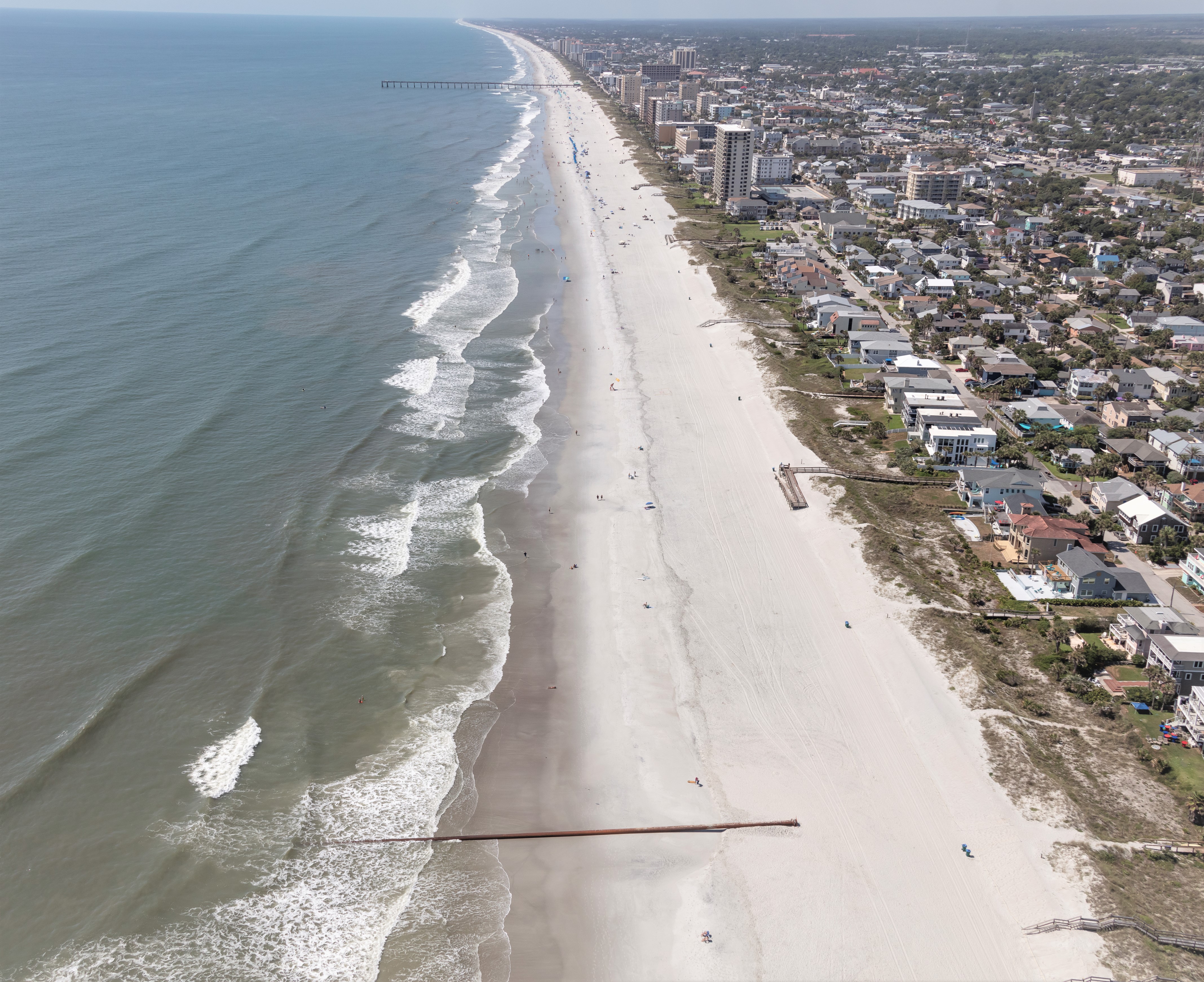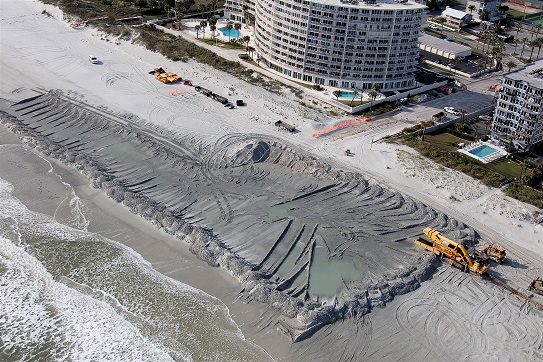USACE Jacksonville completes sand placement for Duval Co. beaches emergency renourishment

USACE Jacksonville District is pleased to announce the completion of beach fill renourishment operations for the Duval County Shore Protection Project.
The federally funded, $32.4 million project has placed approximately 1.3 million cubic yards of sand along the 10-mile section of the county shoreline. Over the next few weeks, the contractor will begin planting 500,000 sea oats and similar dune stabilizing cover vegetation and installing do-not-enter signs along the dunes, moving from north to south.
The final completion date is projected to be the end of September.
USACE Jacksonville bids farewell to the hopper dredge Galveston Island, owned and operated by Great Lakes Dredge & Dock LLC, and thanks our incredible non-federal sponsor, the City of Jacksonville, their architecture engineering consultant, Foth-Olsen, and each of the beach communities for their unwavering support in making this emergency restoration a success.
USACE Jacksonville also appreciates the dedication of the federal and state agencies, lifeguards, beach maintenance crews, environmental monitoring crews, local fire and police teams who contributed to making this project happen without mishap and ahead of schedule.
We extend as well a special thanks to Beaches Sea Turtle Patrol for working around the clock to relocatie sea turtle nests. Your team is incredible and we thank you!
The successful completion of this project will provide countless benefits from everyday recreation opportunities for residents and tourists, to critical nesting habitat for sea turtles and shorebirds, to economic benefits for the area tourism industry and, most importantly, protection from future storm events and sea level rise.
Enjoy the beach!
Jacksonville District to minimize restrictions on Duval beaches for Fourth of July
The USACE Jacksonville contractor will minimize its footprint and suspend operations of its Duval Co. beach renourishment activity for the Fourth of July. On-beach operations will cease by the dawn’s early light on the Fourth of July and resume early on the morning of Friday, July 5. The only area remaining off limits to the public on the Fourth will be a roughly 1,000-foot stretch of beach in the vicinity of 17th St. and 18th St. in Atlantic Beach. The 15th St., 18th St. and 19th St. public access points will remain open; however, beachgoers will have to exit and re-enter the beach to bypass that area.
Once operations resume, the crew will continue sand placement moving southward to meet the northernmost extent of the previously completed section, then reverse direction and build out the beach moving north toward Kathryn Abbey Hanna Park.
The Corps contractor will continue to accommodate beachgoers whenever possible, and thank the public for observing the temporary beach and access closures necessary to ensure public safety.
Have a great Fourth of July!
The 2024 Duval County FCCE beach renourishment is under way

Jacksonville Mayor Donna Deegan speaks at the kickoff event April 29, 2024
USACE Jacksonville District Commander, Col. James Booth, joined a half dozen area elected officials on the sand at Jacksonville Beach April 29, 2024, to mark the beginning of the 2024 Duval County Shore Protection Project renourishment. Mayors Donna Deegan of Jacksonville, Curtis Ford of Atlantic Beach, Christine Hoffman of Jacksonville Beach and Elaine Brown of Neptune were joined by U.S. Rep. John Rutherford to officially inaugurate the $32.4 million beach restoration.
“Hurricanes Ian and Nicole came through and did some pretty good hard work on these engineered beaches, and so Congress has seen fit to give us around $30 million, maybe a little more, and come in at full federal expense, 100 percent federal expense, and restore the project template to as it was originally designed,” said Booth.
Based on the severity of erosion resulting from those 2022 storm events, the Duval Co. federal shore protection project qualified for comprehensive federal funding of the present renourishment under the congressionally authorized Flood Control and Coastal Emergencies, PL 84-99, as did nearly a dozen similar federal shore protection projects around the state.
On site operations began in early May to place up to 1.3 million cubic yards of sand dredged from federally managed offshore borrow areas on the 10-mile Atlantic coastline stretching from Naval Station Mayport in the north to the Duval-St. Johns Co. line in the south.
“The bottom line is that beach renourishment protects lives, property and our economy,” said City of Jacksonville Mayor Donna Deegan. “And it’s more than that. Building up the resiliency of our coastline, as I said, builds the resiliency of our communities. The City of Jacksonville values our partnership with the U.S. Army Corps of Engineers in ensuring the safety of our citizens.
“And while we are hoping we will not need them this hurricane season, they are fantastic at doing emergency management before, during and after a storm.”

Jacksonville District Awards Contract for Duval Beach Restoration
USACE Jacksonville awarded a $32.4 million contract Dec. 18, 2023, to Great Lakes Dredge & Dock Co., LLC, of Houston, Texas, for re-nourishment of approximately 10 miles of the Duval Co. Atlantic shoreline. The Shore Protection Project, Beach Renourishment 2024, Duval Co., Florida, the restoration will reinforce critically eroded beach within the municipalities of Atlantic Beach, Neptune Beach and Jacksonville Beach, extending from the St. Johns River to the Duval-St. Johns Co. line.
The project is 100 percent federally funded through Flood Control and Coastal Emergencies monies.
The beach re-nourishment includes construction of both a dune and beach berm with sand sourced from a federally administered offshore borrow area. Beach restoration work will include beach tilling, vibration control and monitoring, environmental species monitoring and turbidity monitoring.
Operations are projected to begin in April or May 2024, and be complete later in the summer. USACE Jacksonville will advise the public of the start and progress of the re-nourishment through its social media channels.
Duval County Shore Protection Historical Background
The Duval County Shore Protection Project was initially constructed in 1978-80 and includes approximately 10 miles of coastline in northeast Florida. Specific areas include Naval Station Mayport, Hanna Park, Atlantic Beach, Neptune Beach and Jacksonville Beach. Since then, six principal renourishments have been completed (1985-87, 1991, 1995, 2005, 2011 and 2016-17) in addition to periodic placement of maintenance-dredged sand along the Naval Station Mayport coastline.
Jacksonville District is presently producing plans and specifications for an emergency renourishment, which will address the impacts of two 2022 tropical storms, Ian and Nicole. Required permitting and certification by the Corps and its partner agencies are scheduled to be complete in September 2023. The Corps expects to award a contract for beach renourishment in December 2023 and construction will be completed in August 2024 (weather pending).
Beach renourishment typically takes place every five to six years in order to maintain beaches at their original design dimensions as part of the project. The renourishment is funded in partnership with the City of Jacksonville, Florida Department of Environmental Protection, and Duval County, with 38.4 percent of funding provided by the local partners and 61.6 percent by the federal government. The U.S. Army Corps of Engineers manages the project throughout its 50-year lifecycle which ends in 2040.
The goal of engineered shore projects is to reduce risk and promote coastal resilience. Shore projects help to reduce the damages – economic, environmental, infrastructure, human health and safety – of tropical storms and hurricanes. Thousands of residents and businesses in Duval County benefit from this shore project because storm events erode the beach rather than destroying coastal infrastructure. Coastal communities with engineered beaches have historically fared much better than other communities as documented by numerous studies.
Each renourishment corresponds to an engineer-designed template so that when storms occur, they affect the sand placement in the template and reduce impacts to the underlying beach foundation and landside infrastructure. The engineering design, informed by wave and tidal flow analysis, makes best use of the natural system to preserve sand on the beach.
Along with protecting coastal economic stability and recreational opportunities, beach nourishment projects also provide inherent benefits in restoring critical marine and shorebird habitat. It provides more sand for endangered sea turtles, which normally nest on the same beach where they hatch, to find sufficient areas for nesting. Several species of shorebirds also nest along the beach. And, of course, the beach is essential to the area’s economic driver, tourism.
Authority: Section 103 of Public Law 89‐298, Oct. 27, 1965, authorizes the entire SPP.
Authorized: 1965
First Constructed: 1980
Expires: 2040
Cost share: 61.6% federal and 38.4% non-federal